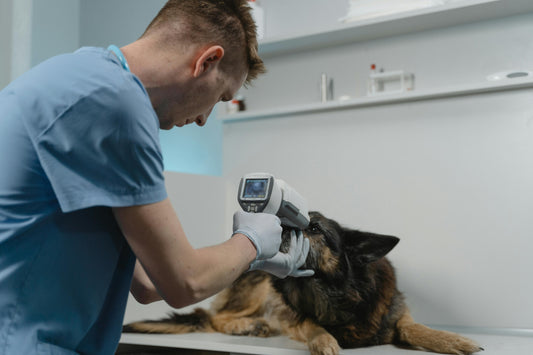If your cat’s breath smells worse than usual, don’t just blame their dinner. A consistently bad odour could be a sign of something more serious, like plaque buildup, gum inflammation or even a hidden health issue. It’s not just about keeping things fresh; it’s about protecting your cat’s wellbeing.
Here are six simple, effective ways to tackle bad breath and improve your cat’s dental health.
1. Start Brushing Your Cat’s Teeth
If you’re wondering how to brush a cat's teeth without a full-blown battle, the trick is to start small. Gently introduce your cat to the sensation by using your finger, then a toothbrush and then to the toothpaste with a short, stress-free routine. Over time, you can build up to a more complete clean.
Brushing a cat's teeth just a few times a week can make a big impact on their breath and prevent serious dental issues down the track.
If you’re wondering how to fix bad cat breath, brushing is the best place to start. It helps reduce the bacteria that cause odour and supports overall dental health.
Regular brushing is the best way to prevent plaque and tartar from taking hold. All you need is a soft toothbrush, or even some muslin cloth, a bit of cat-friendly toothpaste, and some patience. If your cat isn’t used to it, start with short sessions and work your way up.
Focus on the back molars and along the gumline. You don’t need to scrub, just gentle, consistent brushing can make a noticeable difference.
For more info on cat dental health, read our full guide to cat mouth disease.
2. Offer Dental Supplements,Treats And Toys
These can also help if you’re looking for ways on how to make your cat's breath smell better without having to brush daily.
Some supplements, treats and chew toys are specially designed to reduce plaque while your cat eats/chews. These can help support oral hygiene in between brushing sessions, and they’re usually a hit with picky eaters too.
Just make sure any product you use is vet-approved and made for cats.

3. Add A Water Additive or Topper To Their Bowl
It’s one of the easiest tools if you’re trying to figure out how to improve cat breath with minimal effort.
Water additives are easy to use and help keep bacteria in check throughout the day. Add a splash to their water bowl to freshen their breath and reduce the germs that cause bad odour.
Toppers are a great inclusion to your cats food bowl, they work through the blood stream and saliva and help your cats teeth defend against plaque attaching to the tooth.
It’s not a replacement for brushing, but it can be a helpful extra step.
4. Look Into Dental-Supportive Diets
Certain dry foods are made to clean your cat’s teeth while they eat. They’re often larger in size or shaped to create a gentle scraping action against the teeth.
Ask your vet if a dental formula might be a good option, especially if your cat isn’t keen on brushing.
5. Don’t Skip The Vet Check
If brushing and diet changes aren’t helping, it’s time to call your vet. Bad breath can be an early warning sign of cat gum disease, stomatitis in cats, or cat tooth resorption.
Your vet can check for deeper issues and suggest a proper treatment plan, like dental cleaning or extractions.
6. Know When It’s More Than A Mouth Issue
Sometimes bad breath isn’t dental at all. Health conditions like kidney disease, diabetes or digestive problems can also cause odour.
If your cat’s breath smells unusually strong, sweet, or foul, and nothing else is working, get a full check-up. You’ll find more helpful info in our guide: Is gingivitis contagious in cats?
Why Breath Health Is Worth The Effort
Bad breath might seem like a small problem, but it’s often one of the first clues that something is wrong inside your cat’s mouth. When dental issues go untreated, they can lead to bigger health problems, like infections, tooth loss, or even organ strain from bacteria entering the bloodstream.
You know your cat best. If something feels off, even something as minor as a change in the way they chew or a bit of extra drool, it’s worth paying attention. These tiny red flags are often your cat’s way of saying, “Help me out.”

Bonus Tip: Check Their Mouth Regularly
Every few weeks, try to gently lift your cat’s lips and take a look around. You don’t have to do a full dental exam, just look for anything unusual:
- Red or swollen gums
- Yellow or brown tartar
- Loose or broken teeth
- Sores, lumps, or ulcers
Catching something early makes treatment simpler (and often cheaper) in the long run. If your cat won’t let you near their mouth, that’s also a sign that something might be wrong.
Hydration Helps Too
Keeping your cat well-hydrated plays a part in their oral health. Saliva helps wash away food particles and bacteria. If your cat isn’t drinking much, consider a water fountain or adding wet food to their meals.
Hydration also supports kidney function, digestion, and energy, so it’s a win all around.
Keep An Eye On Behaviour
Some of the clearest signs of mouth pain show up in how your cat behaves. Watch for:
- Sudden fussiness with food
- Eating slower or only on one side
- Avoiding grooming
- Less playful or more withdrawn
These changes can be subtle but important. If your cat starts acting differently, don’t brush it off. It might be more than personality; it could be discomfort.
Pulling It All Together
You might be asking: how often should I brush my cat's teeth? Ideally, daily. But even brushing a few times a week helps. Combine that with regular vet checks and supportive products like dental supplements, toppers, treats or water additives, and you’ve got a solid routine in place.
There’s no single answer to how to freshen a cat’s breath; it’s about small, consistent steps that support dental care and detect issues early.
If you ever feel unsure, ask your vet for help on how to brush cat teeth. A little guidance now can prevent big problems later.




